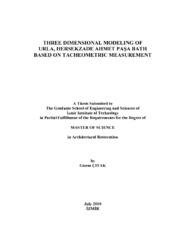Please use this identifier to cite or link to this item:
https://hdl.handle.net/11147/3514Full metadata record
| DC Field | Value | Language |
|---|---|---|
| dc.contributor.advisor | Turan, Mine | en |
| dc.contributor.author | Çıtak, Gizem | - |
| dc.date.accessioned | 2014-07-22T13:51:43Z | - |
| dc.date.available | 2014-07-22T13:51:43Z | - |
| dc.date.issued | 2010 | en |
| dc.identifier.uri | http://hdl.handle.net/11147/3514 | - |
| dc.description | Thesis (Master)--Izmir Institute of Technology, Architectural Restoration, Izmir, 2010 | en |
| dc.description | Includes bibliographical references (leaves: 58-59) | en |
| dc.description | Text in English; Abstract: Turkish and English | en |
| dc.description | xii, 113 leaves | en |
| dc.description.abstract | Reliable documentation is a prerequisite for the conservation and restoration of historic monuments. Using the case study of Hersekzade Ahmet Paşa Bath in Urla, İzmir, three dimensional modeling as a conservation and restoration aimed documentation technique is considered. This study aims to manage the process of the production of easily viewed three dimensional representations of historic monuments with the aim of conservation and restoration. The method of the study comprehends gathering of measured data with tacheometric techniques and their evaluation with three dimensional modeling technique as an interpretation tool for the near-by surrounding, layout and structure of the case study. A series of representation scales; namely 1/200, 1/100 and 1/50; are considered in order to make possible the discussion of various scales of a conservation and restoration design. The site model including the mass geometry, the neighboring masses, roads and the surrounding ground is drawn for printing in 1/200 scale; the caldarium of the women.s section with its building elements such as dome, arch, wall and floor, and its architectural elements such as stone wash basins and marble floor covering, and decorative elements at the arches and domes is drawn for printing in 1/100 scale; and a dome on the caldarium of the women.s section with its oculi, the structural deformations and the remains of plaster is drawn for printing in 1/50 scale. This study states that the technique of three dimensional modeling has great potential for conservation and restoration aimed documentation of historic monuments. The data gathered is easy to interpret, once the principles of modeling are followed. Nevertheless, creating a three dimensional model is not a task to be underestimated since it will take considerable time and manual drafting effort. Thus, the technique should be applied to architectural heritage which necessitates through three dimensional evaluation. | en |
| dc.language.iso | en | en_US |
| dc.publisher | Izmir Institute of Technology | en |
| dc.rights | info:eu-repo/semantics/openAccess | en_US |
| dc.subject.lcsh | Three-dimensional imaging | en |
| dc.subject.lcsh | Architecture--Conservation and restoration--Turkey | en |
| dc.title | Theree dimensional modeling of Urla, Hersekezade Ahmet Paşa Bath based on tacheometric measurement | en_US |
| dc.type | Master Thesis | en_US |
| dc.institutionauthor | Çıtak, Gizem | - |
| dc.department | Thesis (Master)--İzmir Institute of Technology, Conservation and Restoration of Cultural Heritage | en_US |
| dc.relation.publicationcategory | Tez | en_US |
| item.openairecristype | http://purl.org/coar/resource_type/c_18cf | - |
| item.cerifentitytype | Publications | - |
| item.fulltext | With Fulltext | - |
| item.languageiso639-1 | en | - |
| item.grantfulltext | open | - |
| item.openairetype | Master Thesis | - |
| Appears in Collections: | Master Degree / Yüksek Lisans Tezleri | |
Files in This Item:
| File | Description | Size | Format | |
|---|---|---|---|---|
| T000207.pdf | MasterThesis | 6.6 MB | Adobe PDF |  View/Open |
CORE Recommender
Page view(s)
136
checked on Apr 15, 2024
Download(s)
112
checked on Apr 15, 2024
Google ScholarTM
Check
Items in GCRIS Repository are protected by copyright, with all rights reserved, unless otherwise indicated.